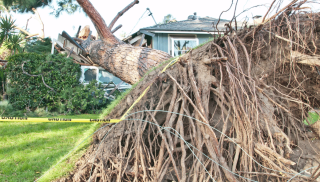Planting trees around your home can enhance its beauty, provide shade, and create a healthier environment. However, not all trees are created equal regarding proximity to houses. Strobert Tree Services brings you a comprehensive guide on the best and worst trees to plant near your home, ensuring your landscape thrives without compromising the structural integrity of your property.
Things to Think About When Planting Trees Near Your House
- Roots: Some trees have roots that can grow into your home's foundation or damage pipes. Pick trees with roots that stay put and won’t cause issues.
- Size: Even small trees can grow very tall over time. Make sure the tree won’t get too big for the space near your house.
- Branches: Think about how wide the tree will get. Large branches could damage your roof or block sunlight from your windows.
- Upkeep: Some trees drop lots of leaves, flowers, or fruit. This can make a mess, clog gutters, or slippery walkways, so choose wisely.
- Utility Lines: Be aware of power lines or pipes underground. Plant trees that won't interfere with these important services.
Best Trees for Proximity to Homes
1. Crabapple
Crabapple trees are a delightful addition to smaller yards. Stunning spring blooms and vibrant fall foliage add aesthetic appeal without overpowering your home. Their non-invasive root systems provide peace of mind by keeping foundation worries at bay.
2. Japanese Maple
For instant curb appeal, consider the iconic Japanese Maple. Its cascading branches and vibrant autumn hues create a dramatic effect. Ensure well-drained soil and occasional pruning to maintain its graceful form.
3. Dogwood
Symbolizing spring, dogwood trees boast delicate blossoms and attractive bark. Their moderate size and shallow root systems make them ideal for smaller spaces. At the same time, their tolerance for various soil conditions adds to their versatility.
4. Weeping Cherry
Imagine a cascade of delicate pink blossoms in spring - that's the weeping cherry. While breathtakingly beautiful, plant them well away from your house and underground utilities to avoid future conflicts due to their eventual size and fast-growing nature.
5. Crepe Myrtle
Thriving in warm climates, the crepe myrtle offers vibrant summer blooms and attractive bark. Choose a variety with a mature height that suits your space, and enjoy its low-maintenance nature and pest resistance.
6. Magnolia (Magnolia stellata or Magnolia grandiflora)
Magnolia trees are beautiful with big, fragrant flowers. Some types, like the Star Magnolia, only grow to about 15 feet tall, making them perfect for smaller spaces. Their roots are not invasive, so they can plant near a house without taking over the yard. Magnolias add charm to any landscape without being too overwhelming.
7. Holly (Ilex spp.)
Holly trees are great for adding privacy to your home. Since they keep their leaves all year, they’re always green. Types like American Holly and Dwarf Yaupon Holly are popular choices to plant near houses because they stay small and don't have roots that spread too much. People often use holly trees as hedges or to decorate around their home's foundation because they grow thick leaves.
The Worst Trees for Proximity to Homes
1. Willow
While willows may seem romantic, their fast-growing, invasive roots can wreak havoc on foundations, pipes, and sidewalks. Additionally, their branches are prone to breakage, posing safety hazards. Save the willows for parks and ponds far from your precious home.
2. Poplar
Poplars are fast-growing giants that offer minimal shade and maximum mess. Their brittle branches and prolific seed production make them a liability near houses and walkways. Opt for a less chaotic tree species for a peaceful and tidy yard.
3. Silver Maple
While maples are generally excellent, the silver maple is an exception. Their aggressive root systems and fast-growing nature make them a nightmare for foundations and plumbing. Stick to other maple varieties for a safer and more manageable addition to your landscape.
4. Elm
Dutch elm disease has decimated elm populations worldwide, making them a risky choice for planting near your home. If you must have an elm, choose disease-resistant varieties like the American Sentry Elm. However, be prepared for ongoing pest and disease management.
5. Eucalyptus
Eucalyptus trees offer quick shade and privacy, but their shallow, invasive roots can damage foundations and compete with other plants for water. Additionally, in dry climates, eucalyptus trees are highly flammable, posing a fire hazard near homes.
Tips for Planting Trees Near Your Home
If you're planting trees near your house, here are some easy-to-follow tips:
- Pick the Right Spot: Choose a place where the tree can grow without bumping into walls, driveways, or buried pipes.
- Give it Space: Even small trees need room. Plant them at least 10-15 feet from your house to avoid damage to your roof or foundation.
- Add Mulch: Mulch around the tree to help it hold moisture, stay cool, and keep weeds away. It also protects the roots from bad weather.
- Trim Often: Regularly trim the tree to keep it healthy and in shape. This prevents dead branches from falling and causing problems.
- Ask an Expert: Not sure where to plant or what type of tree to choose? Reach out to a professional like Strobert Tree Services for advice. They'll help you plant your tree in the best spot for long-term health and safety.
Planting for the Future
Choosing suitable trees for your landscape is crucial to ensure the longevity and safety of your home. Strobert Tree Services is here to assist you in making informed decisions about tree planting and care. Contact us for expert tree care services in Delaware, Pennsylvania, Maryland, and New Jersey. Let's create a beautiful and safe environment around your home together.











